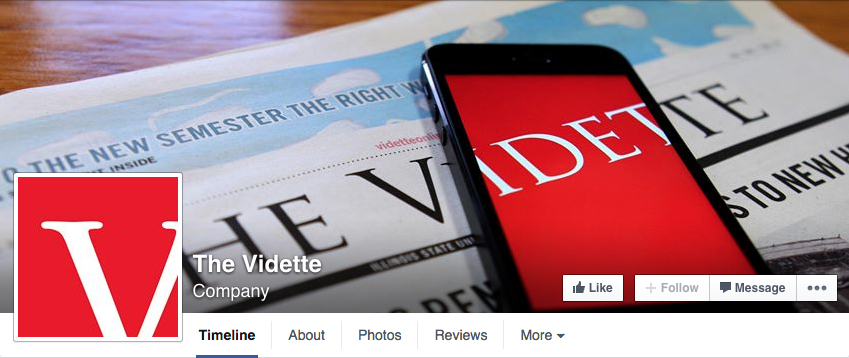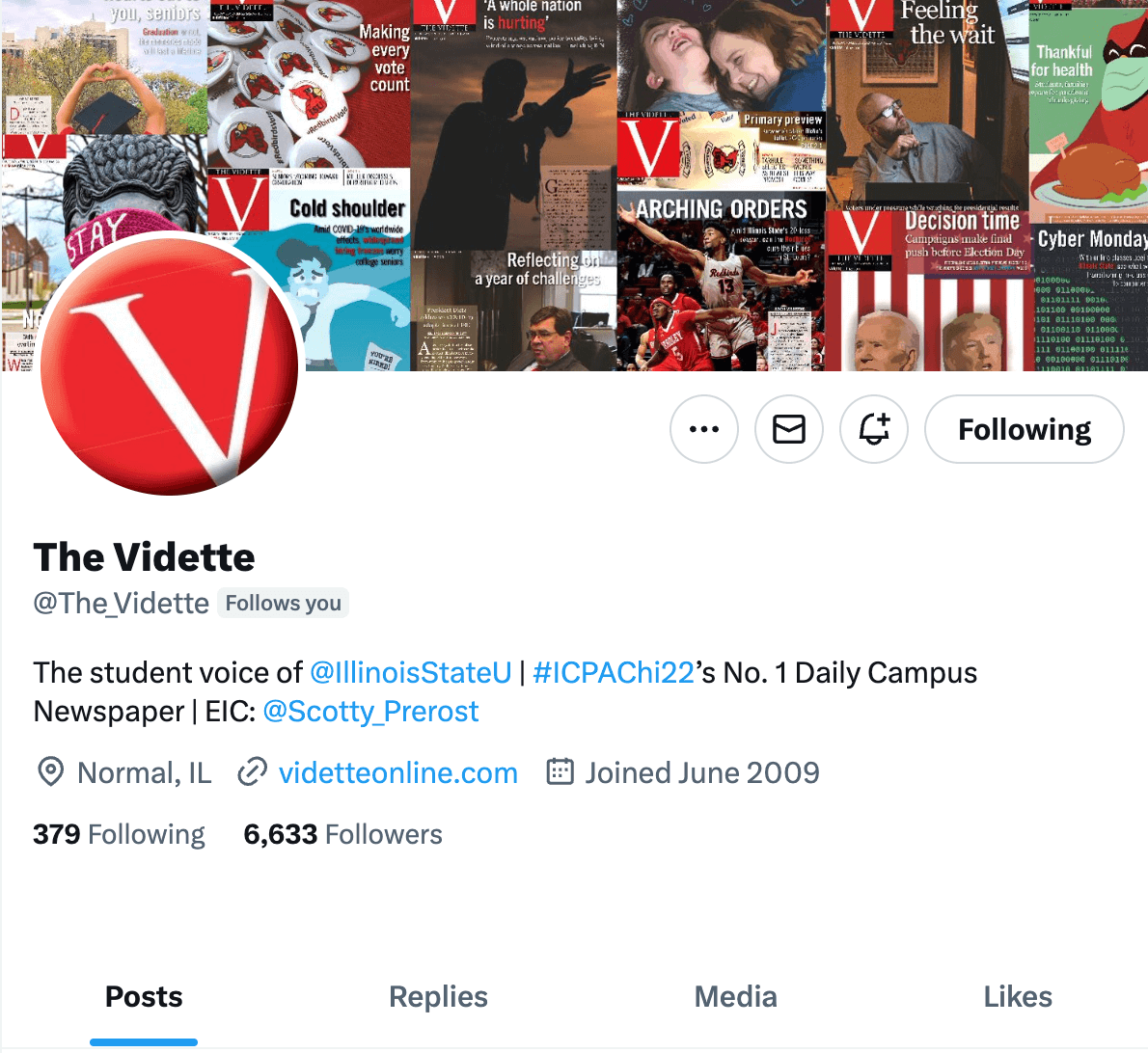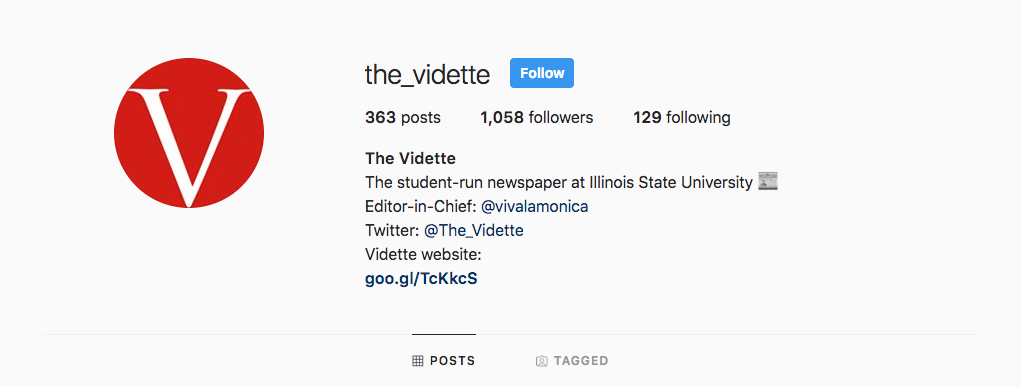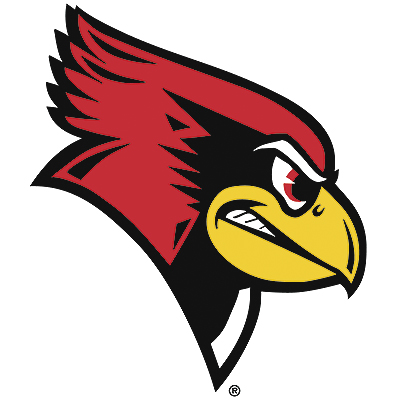Facebook, X, and Instagram
Facebook, X, and Instagram
- Facebook Tactics
Facebook Best Practices

Here are some best practices for managing a Facebook Page representing an ISU campus unit:
Page Cover Photos
These horizontal “front door” photos (820 pixels wide by 312 pixels tall) are important for your Page. If you need help finding campus beauty shots for your cover photo, you can download some on Illinois State's Flickr page or make special requests via SocialNetworks@IllinoisState.edu.
Page Profile Pictures
These small, icon-like images appear next to all of your posts in a user’s News Feed. They need to be uploaded at least 180 pixels wide by 180 pixels tall. Your Profile Picture should not be changed regularly. Consistently using the same photo will allow your audience to develop familiarity with your image as it appears on posts and in their News Feed.
Consistent formatting of Profile Pictures aids in branding. UMC’s graphic standards for profile pictures apply:
- Preferred: Standard University seal with white background. Available at the UMC website.
- Alternative: Your unit's established and official UMC-approved logo or icon.
Not recommended:
- Graphics that are cropped/cut off in square format
- Logos featuring smaller text, which will not display well at this size
- Group shots of students, which will also not display well at this size
Consult UMC's Graphics Standards for how official University logos can be used for marketing purposes.
This Redbird Head has been formatted for Facebook profiles and can be downloaded from this page.
You can also request a custom Profile Picture be created by the UMC design staff by emailing SocialNetworks@IllinoisState.edu. Your unit may incur a small design fee.
Best Practices for Posting
- Use a mix of photos and links. Text-only and video posts generally do not reach large audiences, so they should be used sparingly. Photos reach the largest audiences.
- Keep it short and sweet. Posts should rarely be longer than 2–3 sentences.
- Engage your audience, ask questions, and try to stir up conversation. Facebook’s algorithm for determining what appears in a user’s News Feed is based in part on how many users have already commented or liked a post.
- When you copy-and-paste a link into a post, Facebook automatically recognizes it and turns it into a link with a thumbnail and headline. All you need is a sentence or two of teaser text. Delete the URL from the text once the image is rendered.
- When posting a link, make sure a good thumbnail displays. If it doesn’t, you can click “Upload Image” to add a custom thumbnail.
- Tag other Facebook users, especially other ISU units, whenever possible. (You can do this by typing “@User Name,” and a drop-down menu of possible tags will pop up.)
- Consider repeatable themes, such as “Throwback Thursday” (posting photos from the archives) or points of pride associated with your unit or ISU broadly.
- Photo albums are a great way to engage. It’s best to keep an album to fewer than 20 photos, so users get all the way through. For larger albums, consider creating a Flickr account for your unit, which gives the flexibility to post large volumes of full-size, high-resolution images.
- Reply promptly to direct messages, questions in the comments of your posts, and engage with others.
Facebook video
- Facebook has been seeming to deprioritize video no matter the length. It's hard to anticipate if a video will perform well, whether it's short-form or long-form.
- If you choose to post a video to your Page, upload a native video file . A video file uploaded directly to your Page will auto play in News Feed, increasing views. A YouTube link will not auto play.
- Facebook auto generates captions. Be sure to review and edit these as needed before posting.
Facebook Live
- Write a script. Use your phone to record a practice take and look for lighting and sound issues. Keep in mind that with a Facebook Live, you can’t edit the video, though you can always delete it.
- Keep it short if scripting. A few minutes live is probably all that is required unless you are using the platform to stream an entire event.
- After you do a Facebook Live, you have the option of saving the video to your profile for users to view later. We recommend doing this to maximize the reach of your Live post.
- For tips on how to livestream, check out this video.
Facebook Groups
A Facebook Group is a type of Facebook page that allows users to post content about the group’s topic and discuss it with other individuals in the group. Many units on campus have found groups are a great way to engage their most knowledgeable audiences. Those power users can also educate other users about your office in a way that feels more authentic than posts to a traditional page does. A group can be set up as open to all users, as open to users requesting to join the page, or as open to only those invited to page.
Before creating a group, consider the following:
- What is the goal of the group? Are you looking to grow the group? Keep it small but active? Use it as a hub for your department’s social media ambassadors? It is important to make these decisions upfront to keep the group engaged and on topic.
- Who is going to create content for the page? Even though the goal of a Facebook Group is for users to be the primary generators of content, it is often necessary for group administrators to create content to drive discussion, especially when it is first getting started.
- What are your group’s rules? Groups are meant to generate discussion, which can create passionate responses from your users. Take time to establish what the rules of the group are and what the consequences are if a user breaks those rules.
- Once the rules are established, who will be responsible for moderation? It is important to know who will be responsible for monitoring the discussion.
- X Tactics
X Tactics

Here are some best practices for managing your unit's X feed:
Mentions
Whenever possible, “mention” other Twitter users in your posts. That means you use their X handle (if they have one), such as @ISUDepartment or @CommunityLeaderJane, when referring to them. That sends them a notification they’ve been mentioned, and increases the likelihood they’ll repost you, which increases your audience size.
You can find other ISU X accounts on the Social Media Directory. You can easily find non-ISU X handles by searching Google, e.g., “American Airlines X account.”
Hashtags
When space allows, use unique hashtags to help social media users find and share your content. The official hashtags mentioned below are all great to use on X .
- Admissions and prospective students: #FutureRedbird
- Athletics: #BacktheBirds
- Birds Give Back: #BirdsGiveBack
- College of Applied Science and Technology: #ISUSciTech
- College of Business: #BusinessISU
- Commencement/alumni success stories: #RedbirdProud
- Community service and volunteering: #RedbirdImpact
- Family Weekend: #RedbirdFamily
- Festival ISU: #FestivalISU
- Giving Tuesday: #GivingTuesdayISU
- Homecoming: #RedbirdHomecoming
- Move-in: #RedbirdMoveIn
- Preview: #ISUPreview
- Research and scholarship: #RedbirdScholar
- School of Theatre and Dance: # ISUsotd
- Sibling Weekend: #RedbirdFamily
- Study Abroad: #RoaminRedbirds
- Wear red on Friday: #WearRedOnFridayISU
- Welcome Week: #RedbirdWelcome
Successfully branding a new hashtag can be a big win for your unit. However, search for the hashtag on X , Instagram, and Facebook first to make sure the term is not already being used elsewhere. That could make it more difficult for ISU users to find your content.
Looking for guidance on which hashtag to choose? Email SocialNetworks@IllinoisState.edu.
Reply and reposts
Use your X account to follow similar X accounts, such as other ISU users in your industry, field, or profession. If you see something your users would find interesting, repost it. That will help build your audience, gain you credibility from other users, and provide you with regular new content .
Monitor all replies to your posts (either on your phone or computer) and, if possible, reply to those replies. If someone reposts you, it doesn’t hurt to thank them via reply.
Header photo, profile and bio
The recommended header photo size is 1,500 pixels wide by 500 pixels tall. The recommended profile photo is 400 pixels wide by 400 pixels tall.
Include a link to your unit’s official ISU website to your X profile, as well as a full description of your unit in the “bio” section.
If possible, use the same profile photo for your X profile that you do for your unit’s Facebook Page profile picture. Both are small circles.
This Redbird Head has been formatted for X profiles and can be downloaded from this page.
- Instagram Tactics
Instagram Tactics

Instagram is one of the fastest growing social media platforms. Here are some best practices for managing your unit’s Instagram feed.
Good Photography is Key
Instagram is primarily a photo sharing website, and the highest quality videos and photos engage the best. Thankfully, modern smartphones have cameras that provide high quality as long as you follow some basic rules of composition. It is a good idea to use a photo editing software before posting images. If you aren’t comfortable using Adobe Photoshop, editing apps such as Afterlight and Canva are free and easy to use. Images appear in users’ feeds as 1080 pixels wide by 1080 pixels tall.
Post Content that Engages with your Audience
A great image will get a nice batch of likes, but there are strategies that you can give your content a boost.
- Post regularly: Quality posts are better than quantity. That being said, it is a good idea to post at least once a week to stay engaged with followers.
- Post user-generated content: Your audience is also posting content that they are looking to spread. If it is applicable to your unit, don’t be afraid to regram a post. Be sure to credit the original user! A simple “Credit: @username” will do the trick.
- Similar to Facebook and X, Instagram allows you to schedule posts and videos directly in-app and through Meta Business Suite, in addition to using third-party sites like Hootsuite. If you go this route, consider scheduling posts in advance for the holidays and events throughout the year.
- Ask questions: Don’t be afraid to ask a question such as “What was your favorite class?” Make sure to engage with your followers’ responses.
Tell a Story
Stand-alone photos and videos are a great core for your content, but Instagram Stories is a great way to promote events as they are happening. This feature allows users to save posts to their story which users can watch in sequence. The posts are then deleted 24 hours after publishing. Stories is a great way to engage your audience and experiment while maintaining the strong imagery of your main feed.
The Stories feature is great for covering events and for allowing users to “takeover” the account. Using stories gets messaging out in a way that feels more personable and authentic.
One thing to be careful about is image size, which is 1080 pixels wide by 1920 pixels tall. If you are planning on using premade photos or graphics with this feature, make sure they are in that size ratio. It is easy to cut off the sides of your picture!
Get Discovered
It can be daunting to launch a new social media account. Thankfully, Instagram has a lot of ways that users can maximize the amount of people that see your content. Here are some of the best methods.
- Use hashtags: Instagram users often search a specific hashtag to see content that appeals to them. For university events, the hashtags from earlier in the guide are important to use. Successfully branding your own hashtag can be a great way to expand your core audience. Additionally, you can urge followers to not just follow your account, but any hashtags related to your account.
- Tag users: Similar to Twitter and Facebook, it is always a good idea to tag people and organizations that are relevant to your posts. Additionally, you should always tag users whose content you are regramming as a point of courtesy.
- Use the collab feature: The collaboration tool is a single, co-created feed post or Reel that displays on two profiles at the same time to maximize engagement, boosts your reach, and gets your profile in front of a whole new audience. From campus partnerships, influencer posts, shoutouts, giveaways, the collab tag helps your Instagram account tap into another user’s network.
- Use geolocations: Instagram users also use geolocations to look for content tagged at that location. For example, a prospective student visiting campus might look at the Illinois State University geolocation to get an additional look at what is happening on campus. Tag your posts to get your content in front of more eyes.
This Redbird Head has been formatted for Instagram profiles and can be downloaded from this page.
Creating Reels
Instagram Reels, similar to TikTok, has become the app’s fastest growing feature. Reels are designed to be less than 90-seconds long. Here are some best practices to use Reels:
- Include on-screen text and closed captions. Instagram now has an option for auto-generated captions to make your content accessible-friendly.
- Share your Reels to your feed to boost your views, otherwise there’s a chance your video content will go unseen. If social media branding is important to your account, upload an Instagram Reel cover image to fit with the rest of your content.
- Use hashtags that is relevant to your content. It may increase the likelihood of video views and new followers who are actively engaging with similar content.
- Similar to TikTok, Reels are full-screen vertical video, a 9:16 aspect ratio.
- Post consistently. The University posts two to three Reels a week, making short-form video content a priority.
- Use music from the Instagram library or create your own audio to get your video seen by more users.
- Share your Reel to your Instagram story to increase your reach.
